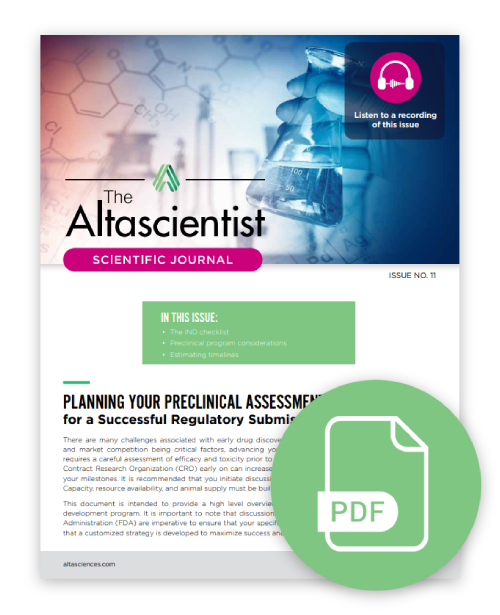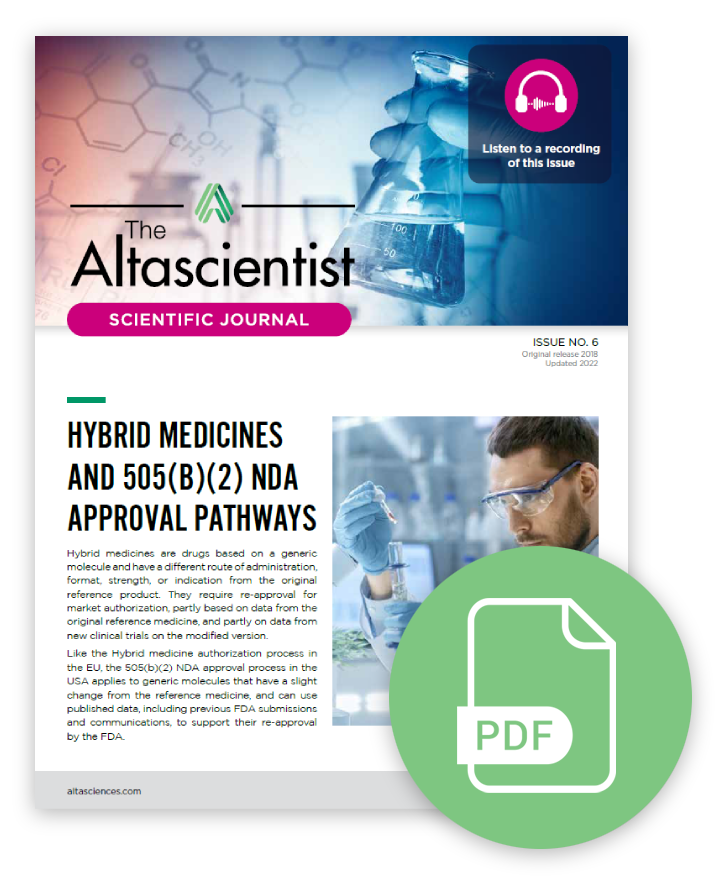Regulatory Affairs
Clinical and Regulatory Considerations for Developing COVID-19 Treatments – a Discussion with our Experts
Up Close and Personal with David Grégoire
David Grégoire joined Altasciences as Director of Quality Assurance in 2012.
ISSUE NO. 11 — Navigating the IND Submission Process
There are many challenges associated with early drug discovery and development. With timelines, budget, and market competition being critical factors, advancing your best candidate for regulatory submissions requires a careful assessment of efficacy and toxicity prior to entering human trials. Partnering with the right CRO early on can increase your chances of success and ensure you meet your milestones. In fact, we recommend initiating discussions with a CRO at least six months in advance to ensure that capacity, resource availability, and animal supply are built into your timelines.
timelines, budget, and market competition being critical factors, advancing your best candidate for regulatory submissions requires a careful assessment of efficacy and toxicity prior to entering human trials. Partnering with the right CRO early on can increase your chances of success and ensure you meet your milestones. In fact, we recommend initiating discussions with a CRO at least six months in advance to ensure that capacity, resource availability, and animal supply are built into your timelines.
In Issue 11 of The Altascientist, we provide a high-level overview of the preclinical component of your drug development program in preparation for regulatory submission, including:
- A submission checklist
- Pivotal toxicology studies
- Small molecules vs. biologics
- Considerations for before you begin (species selection, formulation, test article, bioanalysis, etc.)
- Small and large molecule timelines
- SEND data
- Selecting the right CRO for you
Preparing For Your IND Submission
Your IND application must contain information in the three following areas, as outlined by the U.S. FDA:
- Animal pharmacology and toxicology studies
- Manufacturing information
- Clinical protocols and investigator information
Moving a drug from preclinical testing into the clinic requires that all conditions outlined by the FDA be met. Therefore, it is important that you and your CRO have a thorough understanding of the requirements. Involving regulatory agencies from the start can help lead you in the right direction and ensure a successful IND submission.
It is essential to communicate with the FDA as early as possible to make certain that the test plan is acceptable. The pre-IND meeting is the first crucial interaction with the FDA. This meeting provides an excellent opportunity for you to enlist the FDA's support as well as validate and optimize a strategy.
Planning Your Pivotal Toxicology Studies
Being proactive in your approach and having a clinical strategy before engaging a CRO will ensure that the data provided by the program of work is sufficient to support your IND, and will reduce the risk of study start-up delays.
Considerations for planning your program include safe starting doses for clinical trials and multiple-dose levels (multiples of expected clinical dose), species selection and justification, routes of administration to mimic clinical use, identification of potential target organs for toxicity, planning for assessing reversibility of toxicities, endpoints, and analytical and bioanalytical methods.
Test Article Considerations
Proper formulation of drugs and vehicles helps ensure appropriate exposure to the test article. Vehicle/solubility, consistency, characterization, storage conditions and material safety data sheets must all be taken into consideration.
As such, solubility, stability, dose volume, and tolerability of the vehicle in the preclinical species should be considered. For GLP studies, concentration verification of the test article in the vehicle is required. It is also important that the route of administration for the IND portion of preclinical studies -mimic the route you intend to use in the clinic.
A well-characterized test article must be in accordance with GLP and accompanied by a Certificate of Analysis, and test materials should be stored according to the Certificate of Analysis and within the same conditions under which stability has been established.
Additionally, to ensure safe and proper handling of the material, the safety data sheet should be provided to your CRO study team and laboratory personnel before the test article is shipped.
Explore all issues of The Altascientist in our Resource Center. And don’t forget to subscribe to “The Altascientist: Audiobooks” on Spotify, Apple Podcasts, or wherever you get your audio content.
The FDA Animal Rule and Standard for Exchange of Nonclinical Data (SEND)
ISSUE NO. 6 — Hybrid Medicines and 505(b)(2) NDA Approval Pathways
Hybrid medicines are drugs based on a generic molecule, and have a different route of administration, format, strength, or indication from the original reference product. They require re-approval for market authorization, partly based on data from the original reference medicine, and partly on data from new clinical trials on the modified version.
They require re-approval for market authorization, partly based on data from the original reference medicine, and partly on data from new clinical trials on the modified version.
Like the hybrid medicine authorization process in the European Union, the 505(b)(2) new drug application (NDA) approval process in the United States applies to generic molecules that have a slight change from the reference medicine, and can use published data, including previous FDA submissions and communications, to support their re-approval by the FDA.
In Issue 6 of The Altascientist, we explore the 505(b)(2) NDA approval pathways and their benefits over generic approvals, relevant drug categories, and key strategies for market authorization:
- Applicable categories of drugs for hybrid or 505(b)(2) pathways
- Hybrid or 505(b)(2) vs. generics
- Choosing a drug candidate
- A case study: Achieving a 505(b)(2) Regulatory Approval
Hybrid or 505(b)(2) versus Generic Pathways
Medicines approved via the hybrid or 505(b)(2) regulatory pathways have certain market advantages over generics. Because hybrid medicines deliver additional benefits compared to the reference product (a new delivery system, different formulation, new indication, etc.,) they can be branded, and marketed, with attention to the advancements they bring to treatment.
Generic medicines are considered equivalent to their reference products and, as such, cannot be branded or marketed on their features. Their product insert and safety information are identical to that of the reference product. Generics compete on price, while hybrid or 505(b)(2) products compete based on the improvements they offer (i.e., ease of use, safety, or efficacy). The submission requirements for both types of products also differ, which is why pre-submission meetings with regulatory bodies are essential and serve to establish the exact data sets required.
Altasciences has decades of experience conducting research for modified drugs taking the hybrid or 505(b)(2) approval pathway. In fact, since 2010, we have designed and conducted more than 250 studies that followed these pathways.
Get in touch today to see how we can support your 505(b)(2) application!
Will Biosimilars Replace Biologics?
Biologic drugs came on the market with the production of
What Effect Will the New NIH Policy Have On Multi-Site Research?
In June 2016, the National Institutes of Health (NIH) released a new policy on the use of a
FDA Issues Labeling Change for IR Opioid Medications
On March 22, 2016, the FDA announced that a labeling change will be required class-wide for immediate-release (IR) opioid medications prescribed for pain. According to their announcement, this change is a direct result of the FDA’s “continuing effort to educate prescribers and patients about the potential risks related to opioid use.”